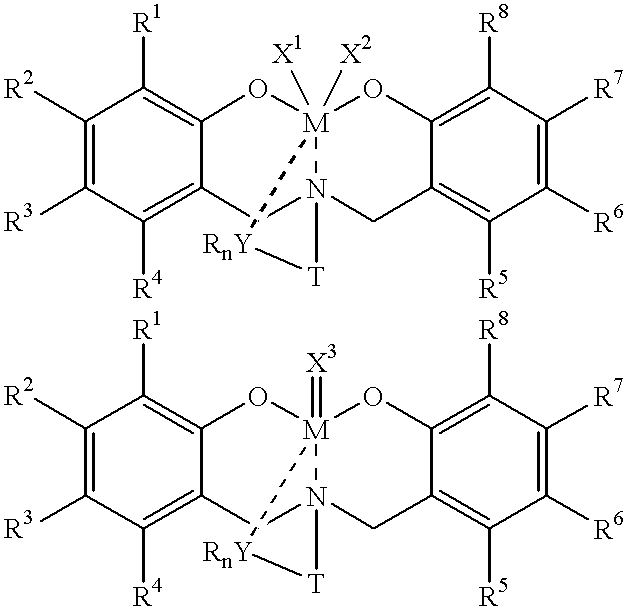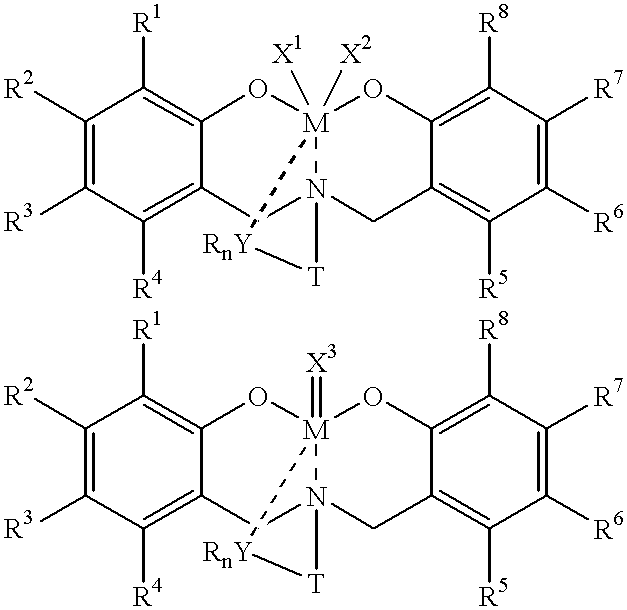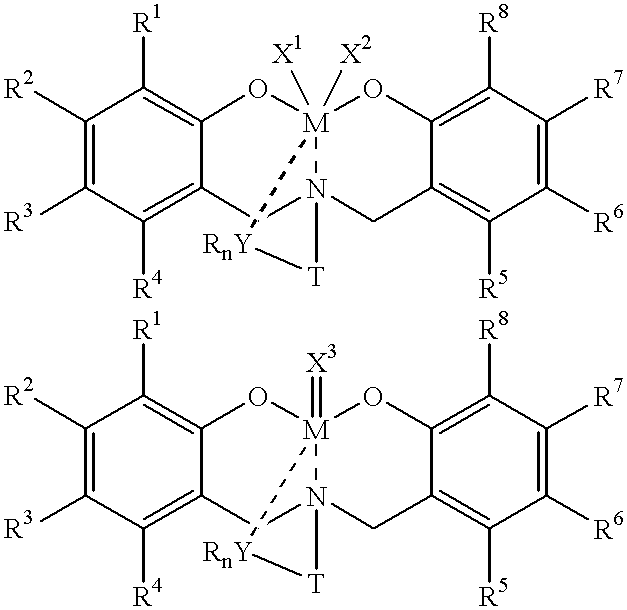Method for catalytic polymerization of alpha-olefin monomers using an ultra-high activity non-metallocene pre-catalyst
a technology of alpha-olefin monomer and catalytic polymerization, which is applied in the activation/preparation of catalysts, chemical/physical processes, and group 4/14 element organic compounds, etc., can solve the problems of low pdi value of -olefin) products, ineffective catalytic catalytic pre-catalytic effect, and no catalytic activity
- Summary
- Abstract
- Description
- Claims
- Application Information
AI Technical Summary
Benefits of technology
Problems solved by technology
Method used
Image
Examples
example 2
Synthesis of amine bis(2-hydroxyarylmethyl) ligand precursor[CH.sub.3--CH.-sub.2--CH.sub.2--] 10
[0160] A mixture of 2,4-di-tert(butyl)phenol (5.0 g, 24.2 mmol), 1-aminopropane (1.0 mL, 12.1 mmol), and 36% aqueous formaldehyde (4.0 mL, 48.0 mmol) in methanol (10 mL), was stirred and refluxed for 24 hrs. The mixture was cooled in a freezer over night and the supernatant solution decanted. The residue was triturated using a triturating solvent such as ice cold methanol, filtered, and washed thoroughly with cold methanol, to give the bis-adduct 10 as a colorless powder (2.7 g, 45.4% yield), which could be further purified by re-crystallization from ethanol.
[0161] Melting point of 10 was 132.degree. C.
[0162] HRMS (high resolution mass spectrometry) of 10: calculated, 495.407630, and observed, 495.406458.
[0163] Spectroscopic Data of 10. .sup.1H NMR (C.sub.6D.sub.6, 200 MHz) .delta.8.21 (s, 2H, OH), 7.48 (d, J=2.3, 2H, Ar), 6.97 (d, J=2.3, 2H, Ar), 3.37 (s, 4H, CH.sub.2), 2.19 (t, J=7.1, 2...
example 3
Synthesis of amine bis(2-hydroxyarylmethyl) ligand precursor [2-Pyridine-CH.sub.2--] 12
[0164] A solution of 2,4-di-tert(butyl)phenol (5.0 g, 24.2 mmol), 2-(aminomethyl)pyridine (1.5 mL, 14.6 mmol) and 36% aqueous formaldehyde (2 mL, 24 mmol) in methanol (8 mL) was stirred and refluxed for 18 hrs. The mixture was cooled in a freezer over night and the supernatant solution decanted. The solid residue was triturated with ice cold methanol, filtered, and washed thoroughly with cold methanol, to give the bis-adduct 12 as a colorless powder (2.81 g, 42.6% yield), which could be further purified by recrystallization from methanol.
[0165] Melting point of 12 was 199.degree. C.
[0166] HRMS of 12: Calculated, 545.410704, and observed, 545.410850.
[0167] Spectroscopic Data of 12. .sup.1H NMR (acetone-d.sub.6, 300 MHz) .delta.8.71 (d, 1H), 7.85 (t, 1H), 7.43 (t, 1H), 7.35 (d, 1H), 7.03 (d, J=1.2, 2H), 7.23 (d, J=1.2, 2H), 3.92 (s, 2H, NCH.sub.2Pr), 3.83 (s, 4H, ArCH.sub.2N), 1.39 (s, 18H, C(CH.sub...
example 4
Synthesis of amine bis(phenolate) ligand-metal chelate pre-catalyst [(CH.sub.3).sub.2N--CH.sub.2--CH.sub.2--]--Zr(CH.sub.2Ph).sub.2 9
[0168] A solution of amine bis(2-hydroxyarylmethyl) ligand precursor [(CH.sub.3).sub.2N--CH.sub.2--CH.sub.2--] 7, as synthesized according to Example 1, (200 mg, 0.38 mmol) in toluene (10 mL) was added drop-wise to a solution of zirconium tetra(benzyl) (0.38 mmol) in toluene (10 mL), at room temperature under nitrogen gas inert atmosphere. The reaction mixture was then heated to 65.degree. C. and stirred for two hours. The toluene was removed from the reaction mixture under low pressure to yield pre-catalyst 9, 99% pure, as a yellow solid. 9
[0169] Spectroscopic Data of 9. .sup.1H NMR (C.sub.6D.sub.6, 600 MHz) .delta.7.74 (d, J=7.1, 2H), 7.62 (d, J=2.4, 2H), 7.39 (t, J=8.1, 2H), 7.05 (t, J=7.3, 1H), 6.95 (d, J=2.4, 2H), 6.90 (d, J=7.1, 2H), 6.73 (t, J=8.0, 2H), 6.55 (t, J=7.3, 1H), 3.45 (br d, J=13.0, 2H, CH.sub.2), 2.70 (s, 2H, PhCH.sub.2), 2.60 (d, J=...
PUM
| Property | Measurement | Unit |
|---|---|---|
| Time | aaaaa | aaaaa |
| Time | aaaaa | aaaaa |
| Pressure | aaaaa | aaaaa |
Abstract
Description
Claims
Application Information
 Login to View More
Login to View More - R&D
- Intellectual Property
- Life Sciences
- Materials
- Tech Scout
- Unparalleled Data Quality
- Higher Quality Content
- 60% Fewer Hallucinations
Browse by: Latest US Patents, China's latest patents, Technical Efficacy Thesaurus, Application Domain, Technology Topic, Popular Technical Reports.
© 2025 PatSnap. All rights reserved.Legal|Privacy policy|Modern Slavery Act Transparency Statement|Sitemap|About US| Contact US: help@patsnap.com



